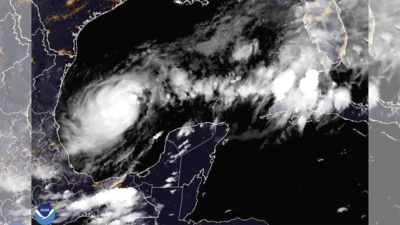
Hurricane Milton It is expected to have a serious impact tampa bay It has strengthened an area as it heads toward Florida’s Gulf Coast Category 5 storm. Forecasts predict a storm surge of 10 to 15 feet, with winds of 165 mph, coming ashore late Wednesday or early Thursday.
It would be the most powerful hurricane to hit Tampa in more than a century, threatening an area already vulnerable due to geography. urban developmentand the lingering influence Hurricane Helen Just two weeks ago.
The Tampa Bay region’s vulnerability to hurricanes, particularly the waves they bring, has long been recognized. The region’s population boom, coastal location, and lack of direct hits since 1921 create a dangerous situation in which a major hurricane could cause unprecedented destruction.
geography and storm surge threaten
Tampa Bay’s geography makes the area highly susceptible to devastating storm surges. The shape of the bay has a narrow opening into the Gulf of Mexico and functions like a funnel, concentrating storm-driven seawater inland.
“The way Tampa Bay is set up, it’s almost certain that we’re going to have waves coming into the bay,” meteorologist Neal Dorst said. NOAAAtlantic Oceanographic and Meteorological Laboratory told the Wall Street Journal.
This surge is further exacerbated by the shallow continental shelf extending from the coast. Shallow waters allow hurricanes to “pile up” water instead of dispersing it, resulting in higher, more damaging storm surges. According to the New York Post, MIT meteorology professor Kerry Emanuel compared storm surges to tsunamis, saying: “Storm surges are physically the same as tsunamis, but they are caused by wind. It’s not caused by the shaking sea floor.
Because of these factors, even a moderate hurricane can cause catastrophic flooding in Tampa. Milton predicted floodwaters of up to 15 feet could flood much of the region, where 50 percent of the population lives below 10 feet above sea level. Such a surge is nearly double what the region experienced during Hurricane Helen.
Population growth and infrastructure vulnerability
In the century since the last major hurricane hit directly in 1921, Tampa Bay has grown into a densely populated metropolitan area with more than 3 million residents. Much of this growth occurs in low-lying areas, increasing the potential for damage and casualties from storm surges. A 2015 study by risk modeler Karen Clark & Co. ranked Tampa as the most vulnerable U.S. city to storm surge flooding and estimated that nearly one-third of the city’s residents live within storm surge zones.
Billions of dollars in private and public investment have gone into developing Tampa’s waterfront, much of it in flood-prone areas. “This is the recipe for huge storm surge disasters,” Jeff Masters, a former NOAA hurricane scientist, told the Wall Street Journal.
Additionally, much of the region’s infrastructure is ill-equipped to withstand a Milton-strength storm. While newer buildings adhere to Florida’s strict building codes and should be able to withstand hurricane-force winds, many older buildings, especially those built before these regulations were implemented, are more susceptible. These communities have not experienced a direct hurricane strike in more than 100 years and may not be prepared for the potential damage from strong winds and flooding.
Impact of consecutive hurricanes: Helen and Milton
The Tampa Bay area is still recovering from the devastation caused by Hurricane Helene less than two weeks ago. Although Helen made landfall north of Tampa, the storm produced a storm surge of more than six feet, causing severe damage to the area.
Houses in low-lying areas were flooded, with water reaching half way to their front doors. Piles of debris, including waterlogged furniture, appliances and destroyed drywall, still line the streets.
Hurricane Milton, which followed Helen, posed a more serious threat. Swells are expected to be twice as high as Helen’s, and many fear Milton’s winds will turn remaining debris into dangerous projectiles, complicating an already dangerous situation.
AccuWeather meteorologist Isaac Longley noted that Helen removed coastal dune and barrier protection, making the area more vulnerable to Milton’s destructive power. The compounding impacts of successive hurricanes could disrupt the region’s infrastructure and its recovery efforts.
Unusual paths and quick reinforcements
Hurricane Milton’s track also raises concerns. Most Atlantic hurricanes move from east to west, but Milton took an unusual path, crossing the Gulf of Mexico from the east-northeast. This rare path gives the storm more time to gather energy from warm Gulf waters, which are currently fueling the storm’s rapid intensification.
“The Milton is doing the opposite and is expected to travel across the entire bay, giving it plenty of time to replenish its energy in warmer water,” Masters said.
The scale of the storm was also shocking. Milton’s wind field is expected to double in size as it approaches the coast, significantly expanding the risk of storm surge and strong winds. This expands the potential area of impact, extending damage to hundreds of miles of coastline north and south of Tampa Bay.
black swan scenario
Experts have long warned of the possibility of a “black swan” hurricane event in Tampa. A 2010 study of a hypothetical Category 5 storm by the Tampa Bay Regional Planning Commission estimated that if a storm hit downtown Tampa with high winds and storm surge similar to Milton’s current forecast, it would kill 2,000 people and cause 2,500 deaths. Billion dollar losses.
“Tampa’s hurricane is the worst-case black swan scenario that experts have been fearing for years,” Emanuel said.
As Milton is on its way to Tampa Bay, the area remains vulnerable to Hurricane Helene and officials are urging residents to heed evacuation orders. As President Joe Biden has emphasized, “This is a matter of life and death.”
Milton could test Tampa Bay’s resilience in a way the region has not experienced in more than a century, highlighting its vulnerability to major hurricanes. Geography, urban growth, and ongoing damage from previous storms put the region at extreme risk. The real test will come when Milton lands.
(Based on input from each agency)







